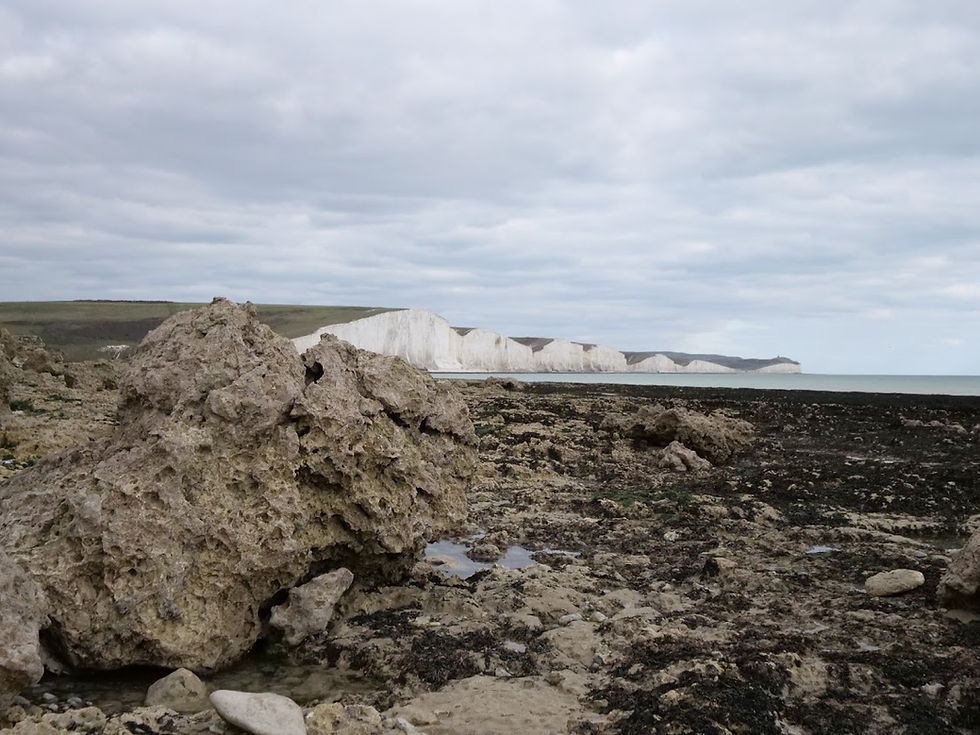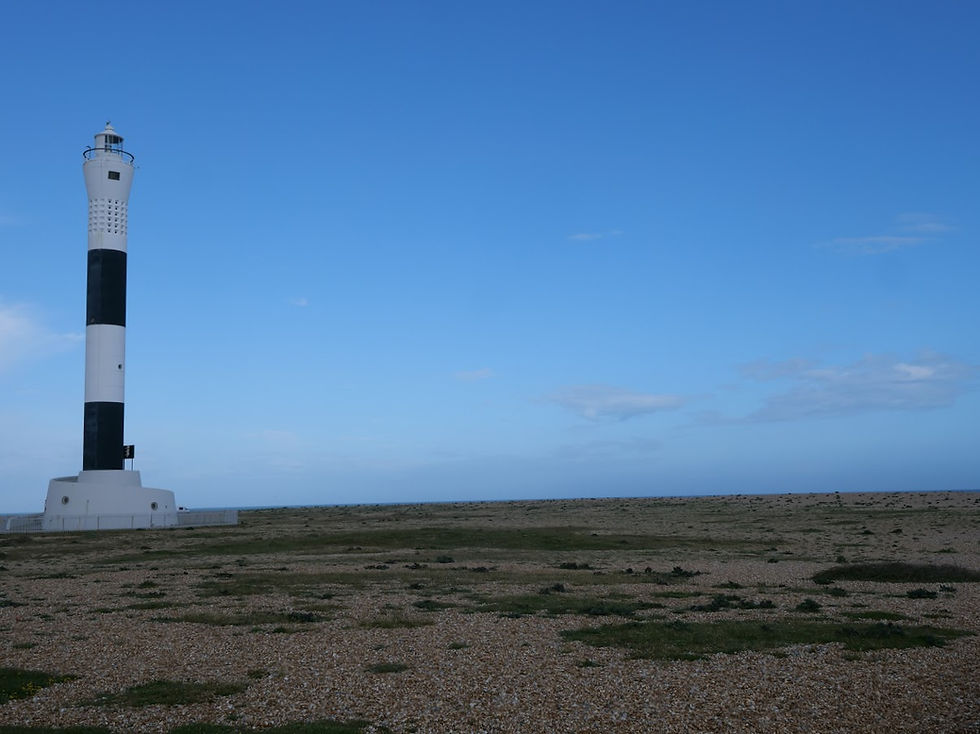25 Views of the Seven Sisters.
- Sim Elliott

- Apr 10, 2021
- 4 min read
This post replaces an earlier version, "32 Views of Cuckmere Haven and the Seven Sisters". I have added a few more photographs, and modified the title, as the post focuses on the Seven Sisters; with 25 photos of the Seven Sisters, and 8 photos of the surrounding landscape.
The Seven Sisters view is perhaps the most iconic view of the British countryside; and is often represented by this image (or a variation of it) showing the Coastguard Cottages at Hope Gap, and the view of the Seven Sisters, from just west of Cuckmere Haven

This image used to advertise travel to the UK, particularly in tour guides published in South East Asia. The popularity of the Seven Sisters as been boosted by there appearance in films films, including Robin Hood: Prince of Thieves, Atonement Mr. Holmes, Hope Gap, Summerland and the Harry Potter series, and in TV programmes, particularly South East Asian programmes; and has led to the Seven Sisters reputation as a "must-see" locations in the UK.
"Topped with green and splashed by blue sea, from a distance the Seven Sisters almost look like a streak of squeezed toothpaste. On a clear day you can see Belle Tout Lighthouse, which stands beyond them on Beachy Head.
You may also have spotted these cliffs onscreen. They have appeared in films including Robin Hood: Prince of Thieves, Harry Potter and the Goblet of Fire and Atonement.
But why does this section of the chalk cliffs appear on TV and film so often?
First, look at the way the cliffs roll up and down towards the horizon. The ‘sisters’ or peaks (from left to right) are called Haven Brow, Short Brow, Rough Brow, Brass Point, Flagstaff Point, Flat Hill, Bailly’s Hill and Went Hill Brow. The troughs between them are valleys. They were carved into the chalk during the Ice Age by summer meltwater from frozen soils. The valleys are roughly at right angles to the current coastline.
You may have already spotted something odd. Look at the cliffs and read the names again. Though called the Seven Sisters, there are technically eight peaks. The cause is erosion by the sea. Constant erosion means the Seven Sisters are retreating by between half and one metre each year. As they recede, the appearance and position of the undulating troughs and hills will change. Centuries from now there may be several new ‘sisters’ exposed by the cliff erosion.
Chalk is a soft rock that water can pass through easily. Sea waves batter the bottom of the cliffs and wear the chalk away. This makes the cliff faces unstable, leading to landslips. These landslips create the Seven Sisters’ bright white colour. What you can see are fresh layers of exposed rock". Seven Sisters viewpoint (discoveringbritain.org)

"When Ms. Shin came from South Korea to see a friend studying near London, a visit to the cliffs was a priority. "It’s the first thing: I told her I want to see Seven Sisters,” she said, explaining in the blustery wind that the cliffs caught her imagination before Big Ben, Buckingham Palace and even the white cliffs of Dover,,, tourists all had a similar response when asked how they knew about the Seven Sisters. “It’s famous!” was the common refrain. The appearance there by the South Korean actress, Seo Hyo-rim, came shortly after a visit to the cliffs by the stars of “One Night Sleepover Trip,” a Korean reality television show. And the Taiwanese singer Jay Chou set one of his music videos [What's Wrong] there." How Asian Social Media Transformed a Quiet U.K. Walking Spot - The New York Times (nytimes.com)
周杰倫 Jay Chou【怎麼了 What's Wrong】Official MV (ft. Cindy袁詠琳)
Landscapes come to represent stereotypes, such as "quintessential England"; in a similar way that images of Mount Fuji in Japan are viewed in the UK as "quintessentially Japanese".
This post attempts to explore the Seven Sisters as a cultural idea that is multidimensional, the way that Hokusai saw Mount Fuji.
"From the age of six I had a penchant for copying the form of things, and from about fifty, my pictures were frequently published; but until the age of seventy, nothing that I drew was worthy of notice. At seventy-three years, I was somewhat able to fathom the growth of plants and trees, and the structure of birds, animals, insects, and fish. Thus, when I reach eighty years, I hope to have made increasing progress, and at ninety to see further into the underlying principles of things, so that at one hundred years I will have achieved a divine state in my art, and at one hundred and then, every dot and every stroke will be as though alive. Those of you who live long enough, bear witness that these words of mine prove not false". Hokusai, in a later edition of 100 Views of Mount Fuji Smith,, quoted in Henry D. (1988) Hokusai: One Hundred Views of Mount Fuji. New York, Braziller & London, Thames & Hudson.
All of the photos in this post were taken on Wednesday 09.04.21.(cloudy, 8C; light Northerly wind) and are presented in the chorological order that they were taken.
I reached Cuckmere Haven by bike and foot. I cycled to Seaford, via Tide Mills, from Brighton and parked my bike next to the Martello Tower; I then walked from Splash Point, across Seaford Head, down to the beach at Hope Gap, and along the beach to Cuckmere Haven (N.B. walking the beach from Hope Gap to Cuckmere Haven; is not without risk; and it is only possible at all at very low tides, and if you are wearing suitable footwear, as that route has many trip hazards. I walked across the beach at my own risk, as the signage warns there is no access to Cuckmere Haven from Hope Gap and I advise you not to take this route).
The photos were taken from=the Seaford Head foot path; Hope Gap; and Cuckmere Haven Beach. All these photos were taken with a Panasonic Lumix DC-G9; mostly using a Panasonic Leica DG Vario-Elmar 8-18mm f/2.8-4 ASPH zoom lens, with a few using a Vario-Elmar 100-400mm f/4-6.3 ASPH Power O.I.S. zoom lens.




































Comments